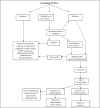The laboratory diagnosis of HIV infections
- PMID: 18159524
- PMCID: PMC2095005
- DOI: 10.1155/2005/515063
The laboratory diagnosis of HIV infections
Abstract
HIV diagnostic testing has come a long way since its inception in the early 1980s. Current enzyme immunoassays are sensitive enough to detect antibody as early as one to two weeks after infection. A variety of other assays are essential to confirm positive antibody screens (Western blot, polymerase chain reaction [PCR]), provide an adjunct to antibody testing (p24 antigen, PCR), or provide additional information for the clinician treating HIV-positive patients (qualitative and quantitative PCR, and genotyping). Most diagnostic laboratories have complex testing algorithms to ensure accuracy of results and optimal use of laboratory resources. The choice of assays is guided by the initial screening results and the clinical information provided by the physician; both are integral to the laboratory's ability to provide an accurate laboratory diagnosis. Laboratories should also provide specific information on specimen collection, storage and transport so that specimen integrity is not compromised, thereby preserving the accuracy of laboratory results. Point of Care tests have become increasingly popular in the United States and some places in Canada over the past several years. These tests provide rapid, on-site HIV results in a format that is relatively easy for clinic staff to perform. However, the performance of these tests requires adherence to good laboratory quality control practices, as well as the backup of a licensed diagnostic laboratory to provide confirmation and resolution of positive or indeterminate results. Laboratory quality assurance programs and the participation in HIV proficiency testing programs are essential to ensure that diagnostic laboratories provide accurate, timely and clinically relevant laboratory results.
Keywords: HIV antibody test; HIV diagnosis; HIV testing algorithm; HIV testing and quality assurance; Polymerase chain reaction (PCR).
Figures
References
-
- Bartlett JG, Gallant JE. 2000-2001 Medical Management of HIV Infection. Baltimore: Port City Press, 2000.
-
- Centers for Disease Control and Prevention. Revised guidelines for HIV counseling, testing, and referral. MMWR Recomm Rep 2001;50:1-57. - PubMed
-
- Zhang M, Versalovic J. HIV update. Diagnostic tests and markers of disease progression and response to therapy. Am J Clin Pathol 2002;118(Suppl):S26-32. - PubMed
-
- Division of STD Prevention and Control, Bureau of HIV/AIDS, STD and TB, Laboratory Centre for Disease Control, Health Protection Branch, Health Canada. Canadian STD Guidelines, 1998 edn. Ottawa: Health Canada, 1998.
LinkOut - more resources
Full Text Sources
Other Literature Sources
Miscellaneous


